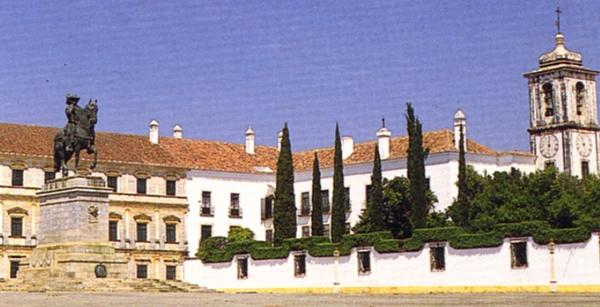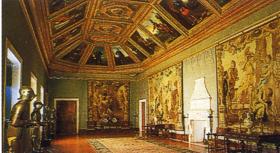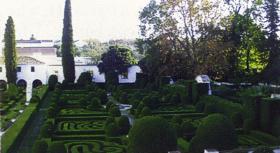|
Vila
Viçosa |
|
Vila
Viçosa |
This was the former residence of the Dukes of Braganza from the beginning of the 16th century and was commenced in 1501-1502 (the north wing) and completed in the 18th century. The main façade is completely covered with local marble and takes Italian Renaissance architecture as its inspiration. The building has three floors and each one, from the ground floor to the last, corresponds to one of the classical orders: Doric, Ionic, and Corinthian. |

| Within the fifty rooms open to the public are housed precious private art collections and extremely rare books which originally belonged to King Manuel II, Portugal's last reigning monarch. The art collection includes paintings by the best Portuguese artists of last century, Flemish and French tapestries, frescoes on walls and ceilings, furniture, porcelain from the Far East, Portugal, Italy and other countries, old armor including some very rare pieces made in the Far East, Portugal, Germany, France, etc. In the Library, which houses over 50,000 volumes and has a public reading room, there is a reserved collection of old Portuguese printed books (15th and 16th century), amongst which are to be found first editions of Os Lusíadas (1572), Comentários ao Pentateuco (1489), Vita Christi (1495), Almanaque de Abrado Zacuto (1496), Livro de Marco Paulo (1502), Tratado da Esfera by Pedro Nunes (1537), etc. |
 |
 |
This open and airy square, with a total area of about sixteen thousand square meters is one of the most beautiful ones in the country. It is situated at the entrance of this noble and aristocratic town, when entering from Borba, Estremoz and the border town of Elvas. To its right are the Royal Chapel and the Palace gardens. |

|
|
| Vila Viçosa has many churches, some
of them of great historical and artistic interest and well worth a visit.
|
|
MUSEUMS |
| Weaponry Museum The first part of this rich assemblage of rare pieces, of great and rare beauty, was inaugurated in June 1992 and the last part in October 1997. Both parts integrate weapons and other pieces for hunting signed weapons and shooting, namely, by Franz Mazemkof, a rifle Bartolomeu Gomes, an English blunderbuss with six barrels (c. 1850), and the gun used by the Royal Prince in the 1908's regicide. There are still the exotic weapons of King Fernando II's collection, the American weapons offered to King D. Carlos, and the hunting weapons he used. |
| The Palace Treasure Its most important piece is the so called "Cruz de Vila Viçosa" (Vila Viçosa's Cross) with a relic of the Holy Cross inside, a masterpiece of great artistic beauty made between 1656 and 1673 by Filipe Valejo by charge of the Duke of Braganza João II, future King João IV. In this exhibition we can also see more than 170 beautiful jewelry pieces, as the cross of Catherine of Braganza, the Caravel cutlery case offered by the monarch to King Manuel II when he married, pieces of the religious cult. Beside other jewelry pieces, in this part of the museum, there are also magnificent paintings and Flemish tapestries of the 15th century, gold liturgical garments and some remarkable pieces of artistic pottery. |
| The Archeology Museum Inaugurated in May 1999 expose, such as the previous ones, under the care of the House of Brabanza's Foundation, in several rooms on the ground floor of the Castle a remarkable collection of archaeological pieces of different periods, with relief to the roman pieces found in the region and to the collections gathered by King Luis I. |
| The Musical Archive
Library Museum in the House of The Musical Archive Library Museum there is a precious musical archive formed by a large number of pieces proceeding from the ancient school of music, from the Ducal chapel, offered by the 8th Duke of Braganza Duke D. João II (John II), later on King D. João IV (John IV), who was an extraordinary composer. This archive also possesses a rare collection of opera librettos from the 18th and 19th centuries it can be consulted in the reading rooms in the Library Museum. |
| The Municipal Historical
Archive In association with the library of ancient books (from the 15th to the 19th centuries), in the town we can visit and consult the important historical archive of the City Hall, that also integrates the Misericordia's Archive, composed by almost 2000 books, old manuscripts and several documents dated from the 15th to the 19th century. |
| House of Braganza
Historical Archive Situated in the Ancient Bishop Palace, this historical archive, the richest private archive from the country, is constituted by almost 200,000 pieces, chronologically placed between the 15th and 19th centuries. From its contents we can point out some parchments from the 15th century, codices, from the 16th century such as the Books of Mercies of ancient House of Braganza from 17th to 20th centuries connected with the ducal chancellery and the ancient "almoxarifado" (tax collectors) from Minho and Trás-os-Montes to Alentejo. Although having an almost administrative features, it's an important collections to the national, regional and local historical investigation, also available to be consulted in the reading rooms of the Ducal Palace |
| Portugal > Tourism > Alentejo > Vila Viçosa - Sightseeing | |
|
Sightseeing |